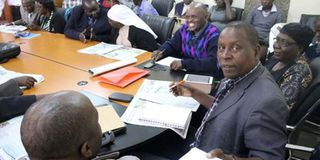Special needs schools heads to hold first-ever forum Monday

Heads of special-needs schools at a consultative meeting with education stakeholders at the Ministry of Education offices in Jogoo House, Nairobi, on January 5, 2016. The heads are set for their first-ever conference on August 29, 2016. PHOTO | JEFF ANGOTE | NATION MEDIA GROUP
What you need to know:
Statistics indicate that one in every 10 Kenyans below 21 is disabled as compared to the global estimates of about two out of 10 people.
The first-ever conference for head teachers of special needs schools is set for Monday at the Kenya Institute of Curriculum Development (KICD).
Special Schools Heads Association chairman Arthur Injenga said the focus of the meeting will be on curriculum reforms for special need education learners in the country.
A total of 500 heads and teachers in charge of special school units will attend the conference that will be launched by Education Cabinet Secretary Fred Matiang’i and closed by the Teachers Service Commission.
“We will, among others, discuss issues and challenges facing this education sector,” said Mr Injenga.
A report on curriculum review dubbed “Research Report on the Needs Assessment for Curriculum Reform” by KICD has recommended that literacy and numeracy skills, languages, speech training, orientation and mobility and sign language should be considered as learning areas in the schools.
The report also notes that there is need to modify instructional strategies to address learning difficulties in an inclusive setting.
“The findings of the needs assessment indicated preference for formative assessment, continuous assessment, project and use of observation as appropriate assessment methods for learners with special needs,” adds the report.
The study also found that the infrastructure and resources in many schools were not adequate and relevant for learners with disabilities.
“For instance, even though most schools had infrastructure facilities such as toilets and classrooms, some of the facilities were inaccessible to children with disabilities due to the absence of ramps and adapted desks, toilets and doors,” it states.
Statistics indicate that one in every 10 Kenyans below 21 years is disabled as compared to the global estimates of about two out of 10 people.





